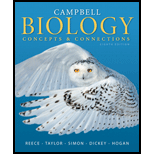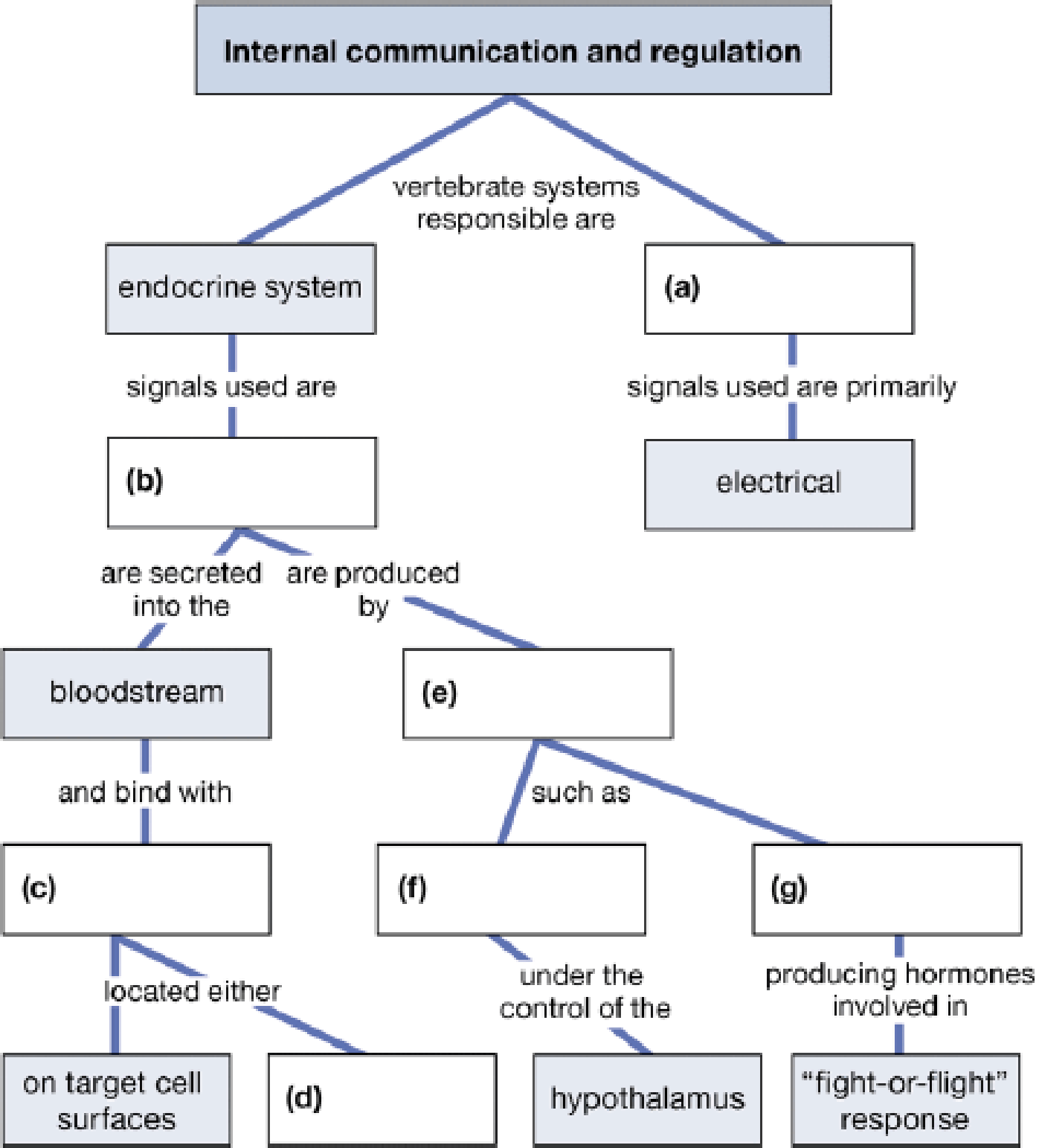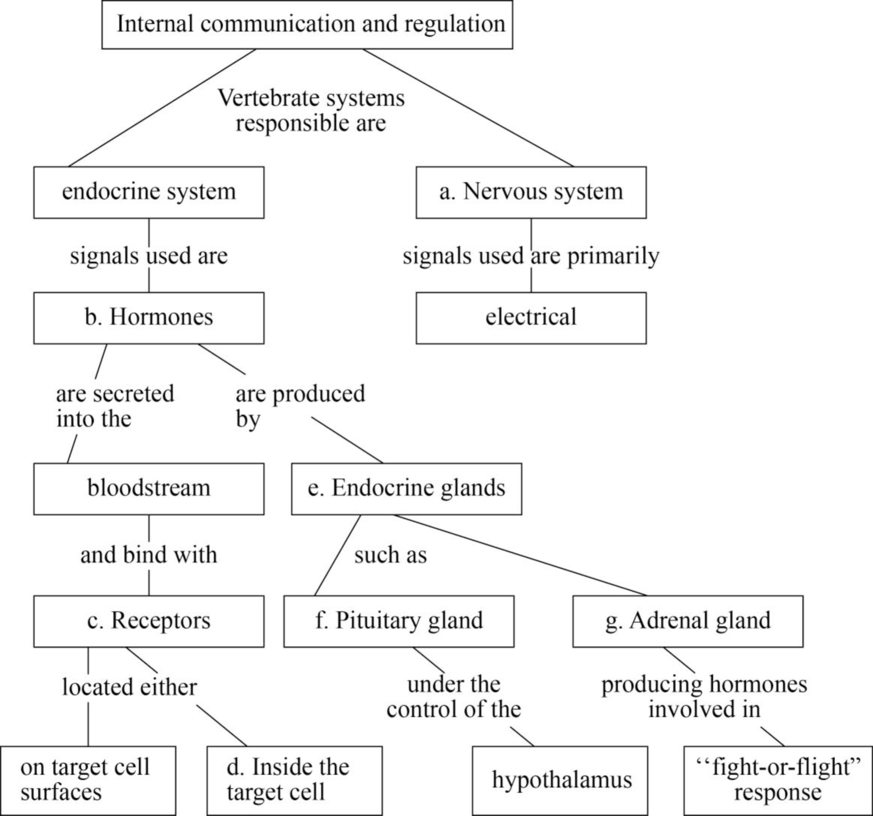
Concept explainers
Complete this map, which presents some major concepts from this chapter.

To complete: The given map that shows the internal communication and regulation.
Introduction: There are two major ways of internal regulation and communication. These are regulated by hormones (chemical substances) and neuronal communication (electrical signals). Neuronal regulation is carried out by neurons either electrically or by the help of neurotransmitters. Hormonal regulation is carried out by hormones that are usually peptides or steroid molecules.
Answer to Problem 1CC
Pictorial representation: Fig. 1 represents the chart of the internal communication and regulation by hormones in vertebrates.

Fig. 1: Internal communication and regulation.
Explanation of Solution
(a)
Correct answer: Nervous system
The nervous system is the organ system of the body, which conducts nerve impulses in the form of electrical signals that pass along the dendrites to generate an action potential. Hence, the correct answer is nervous system.
(b)
Correct answer: Hormones
Hormones are the chemical substances that are secreted by a special group of cells or tissues called the endocrine glands. They pour their secretions into the bloodstream. The exocrine glands are also found in our bodies, which pour their secretions in a tube or a duct. Hence, the correct answer is hormones.
(c)
Correct answer: Receptors
Receptors are the structures that are mostly made up of proteins whose function, as the name suggests, is that they receive the signals or the chemicals or hormones and thereby transmit or elicit a response in the cell on which they are present. Hence, the correct answer is receptors.
(d)
Correct answer: Inside the target cell
Receptors are present inside or outside the cell. They receive the hormones that are secreted by the endocrine glands. Their functioning is regulated either by the hormone itself or by some other biomolecules. Hence, the correct answer is inside the target cell.
(e)
Correct answer: Endocrine glands
Hormones are the chemical substances or biomolecules that are secreted or formed by the endocrine cells. The chemical substances that are formed by the exocrine glands are called secretions. Secretions are poured into a tube or a duct, whereas the hormones are secreted directly into the bloodstream. Hence, the correct answer is endocrine glands.
(f)
Correct answer: Pituitary gland
The pituitary gland is also called the master gland as it controls the functioning of all the other endocrine glands. However, this gland is also regulated by the hypothalamus, which is a part of the brain. Hence, the correct answer is pituitary gland.
(g)
Correct answer: Adrenal gland
The adrenal gland is also called the suprarenal gland as it is located above the kidneys. It secretes a hormone called adrenaline, which is also called the 3F hormone or the emergency hormone as this provides the support for the response that is needed in emergency conditions like fighting or in fearful conditions. Hence, the correct answer is adrenal gland.
Want to see more full solutions like this?
Chapter 26 Solutions
Campbell Biology: Concepts & Connections (8th Edition)
- In one paragraph show how atoms and they're structure are related to the structure of dna and proteins. Talk about what atoms are. what they're made of, why chemical bonding is important to DNA?arrow_forwardWhat are the structure and properties of atoms and chemical bonds (especially how they relate to DNA and proteins).arrow_forwardThe Sentinel Cell: Nature’s Answer to Cancer?arrow_forward
- Molecular Biology Question You are working to characterize a novel protein in mice. Analysis shows that high levels of the primary transcript that codes for this protein are found in tissue from the brain, muscle, liver, and pancreas. However, an antibody that recognizes the C-terminal portion of the protein indicates that the protein is present in brain, muscle, and liver, but not in the pancreas. What is the most likely explanation for this result?arrow_forwardMolecular Biology Explain/discuss how “slow stop” and “quick/fast stop” mutants wereused to identify different protein involved in DNA replication in E. coli.arrow_forwardMolecular Biology Question A gene that codes for a protein was removed from a eukaryotic cell and inserted into a prokaryotic cell. Although the gene was successfully transcribed and translated, it produced a different protein than it produced in the eukaryotic cell. What is the most likely explanation?arrow_forward
- Molecular Biology LIST three characteristics of origins of replicationarrow_forwardMolecular Biology Question Please help. Thank you For E coli DNA polymerase III, give the structure and function of the b-clamp sub-complex. Describe how the structure of this sub-complex is important for it’s function.arrow_forwardMolecular Biology LIST three characteristics of DNA Polymerasesarrow_forward
- Health Safety And Nutrition F/Young ChildHealth & NutritionISBN:9781305144767Author:MAROTZPublisher:Cengage
 Biology Today and Tomorrow without Physiology (Mi...BiologyISBN:9781305117396Author:Cecie Starr, Christine Evers, Lisa StarrPublisher:Cengage LearningCase Studies In Health Information ManagementBiologyISBN:9781337676908Author:SCHNERINGPublisher:Cengage
Biology Today and Tomorrow without Physiology (Mi...BiologyISBN:9781305117396Author:Cecie Starr, Christine Evers, Lisa StarrPublisher:Cengage LearningCase Studies In Health Information ManagementBiologyISBN:9781337676908Author:SCHNERINGPublisher:Cengage  Biology (MindTap Course List)BiologyISBN:9781337392938Author:Eldra Solomon, Charles Martin, Diana W. Martin, Linda R. BergPublisher:Cengage Learning
Biology (MindTap Course List)BiologyISBN:9781337392938Author:Eldra Solomon, Charles Martin, Diana W. Martin, Linda R. BergPublisher:Cengage Learning





